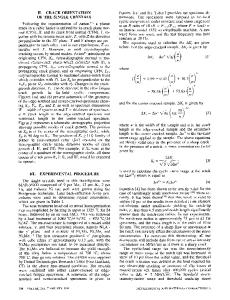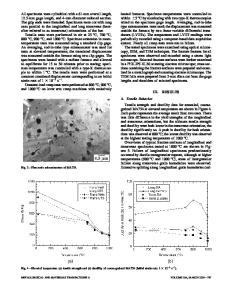The Effect of Crystallographic Orientation on The Mechanical Properties of a single Crystal NiAl+Fe Alloy
- PDF / 375,292 Bytes
- 6 Pages / 420.48 x 639 pts Page_size
- 21 Downloads / 342 Views
THE EFFECT OF CRYSTALLOGRAPHIC ORIENTATION ON THE MECHANICAL PROPERTIES OF A SINGLE CRYSTAL NiAI+Fe Alloy
D.F. Lahrman, R.D. Field, and R. Darolia Engineering Materials Technology Laboratories, GE Aircraft Engines, 1 Neumann Way, Cincinnati, OH 45215.
ABSTRACT In this study, the room temperature tensile properties of a single crystal NiAl alloy were investigated as a function of orientation. Fifteen crystallographic orientations were tested, including the , and . The tensile properties measured include yield strength, plastic strain to failure, and ultimate tensile strength. Room temperature ductility as high as 1.4% was measured as close as 100 from the orientation.
INTRODUCTION The development of advanced gas turbines depends upon achieving higher operational temperatures and thrust to weight ratios. In order to meet these performance requirements, intermetallic compounds such NiAl are being evaluated because of their lower densities compared to nickel-based superalloys. The predicted payoff for an intermetallic alloy such as NiAI with a density of 5.8 g/cc compared to 8.3 g/cc for state of the art superalloys, is a rotor weight savings of up to 50%. Stoichiometric NiAl has been extensively evaluated by several investigators to determine its operative slip systems and deformation properties [ 1-5], and to identify the reason for its lack of low temperature ductility. These investigators have measured the mechanical properties of polycrystalline and single crystal NiAl as a function of temperature and stoichiometry in tension and compression [6-91. Other investigators [10-15] have alloyed NiAl to improve such properties as low temperature ductility and elevated temperature rupture strength. Darolia et al [13-15] have successfully increased the ductility of oriented NiAl single crystals from 1% to -6% by microalloying with Mo, Ga or Fe, although these additions have not increased the ductility in the orientation. The mechanisms for these effects are currently being investigated [16]. Cr has been added to NiAI with the hope of lowering the anti-phase boundary energy and thus providing additional slip systems [17,18,19]. None of these alloying additions have been shown to increase the number of slip systems. If single crystal NiAl alloys are to be used as structural materials such as turbine airfoils, the mechanical properties as a function of crystallographic orientation need to be characterized. In this study, the room temperature tensile properties of a NiAI+Fe alloy were measured for several orientations to determine strength, ductility and the applicability of Schmid's Law. The alloy selected for this study was Ni-49.75AI-0.25Fe (atomic percent), which has -6% plastic strain to failure in the orientation in a room temperature tensile test.
EXPERIMENTAL PROCEDURE Single crystal slabs, 25mm x 32mm x 100mm, of Ni-49.75AI-0.25Fe were grown in argon by a Mat. Res. Soc. Symp. Proc. Vol. 288. 01993 Materials Research Society
680
Bridgman method. The slabs were homogenized in a flowing argon atmosphere at 1316TC
Data Loading...











